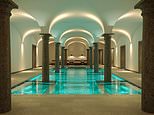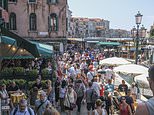
It could be the plot of a Hollywood movie.
Hidden behind huge locked gates lies an ancient former seminary and a vast secret courtyard.
It sat untouched for decades at the heart of Italy’s fashion capital, Milan, until its chance discovery by a very well-connected resident.
Now after ten years of negotiation, planning, design and construction, vibrant new life has been breathed into this extraordinary space – something that looks like the most stylish of film sets.
The 16th-century seminary (a college for priests) has been transformed into Portrait Milano, a stunning new hotel. The huge paved courtyard, now renamed Piazza del Quadrilatero, is the largest public square in Milan’s renowned fashion district.
The giant Baroque gates stand open and the piazza provides a pedestrian route from bustling Corso Venezia to the exclusive designer haunts of Via Sant’Andreais. Far more than just a stylish cut-through, the imposing square hosts boutiques, bars, restaurants and regular exhibitions.
Ian Walker checks into Portrait Milano, a seminary-turned-hotel that lies in Milan’s fashion district
The building, which was ‘untouched for decades’ before its renovation, overlooks a ‘vast secret courtyard’
Success on such a grand scale is testament to the vision and determination of Leonardo Ferragamo, chairman of the famed luxury brand Salvatore Ferragamo, and Valeriano Antonioli, the man who first glimpsed the seminary from the top floor of a neighbouring site and the chief executive of Lungarno Collection, the company’s growing hospitality arm.
The total spend of the ambitious project remains shrouded in mystery, but the 73 rooms of the hotel, by far the largest Ferragamo offering to date, scream opulence, from the deep pile of the cardinal red rugs, larch-boarded floors and Carrara marble bathrooms to the studded, polished wood, felt, leather and lined clothes storage areas reminiscent of 19th-century luxury steamer trunks.
Details such as the elegant spiral door handles, which appear to be made of wood but are actually of tooled leather, and framed design sketches give a nod to the Ferragamo history of creating exquisite footwear and fashion.
When I visited locals and guests alike strolled through Milan’s newest piazza expressing their appreciation for access to a space most never knew was there. Antonioli admits he was astonished when he first set eyes on the seminary, having regularly cycled past the closed gates, with no idea of the ‘magnitude’ of the site behind it.
Above is the seminary before the restoration. ‘The total spend of the ambitious project remains shrouded in mystery,’ says Ian
An impressive spa, 19m (62ft) pool and fitness complex are due to open later this summer
Despite the Ferragamo pedigree it took two years of discussion to green-light the development under a 30-year lease agreement with the Catholic Church.
It took a further eight years to overcome planning and construction hurdles to ensure the preservation of the historic structure, including the spectacular first-floor double loggia colonnades while installing heating, air conditioning, elevator banks and the rest of the paraphernalia expected of a luxury hotel.
Architect Michele De Lucchi more than fulfilled his brief with strikingly innovative 15-ton sheets of sliding glass installed behind the 152 first-floor columns, creating a spacious terrace and seating area outside rooms that can be either open or protected from the weather.
An equally impressive spa, 19m (62ft) pool and fitness complex are due to open later this summer.
The luxe interiors by Michele Bonan are subtle, classic and comfortable, featuring velvets, tweed, buttery soft leather, walk-in closets and huge beds.
It is impossible to stay here and not applaud the monumental achievement in transforming this building, which was founded in 1565 and has incorporated many additions and renovations along the way, but key to its success is not only the sympathetic treatment of its classic lines and grand proportions.
The rooms of the hotel ‘scream opulence’, Ian reveals, from the deep pile of the cardinal red rugs to the larch-boarded floors
Ian admires the Carrara marble bathrooms adjoining the hotel’s guestrooms
Those efforts would be harder to appreciate were it not for the proficient and endearing staff. If they had tails they would definitely be wagging them at the sight of new guests, such is the genuine welcome at reception and their unfeigned enthusiasm for the hotel and piazza.
Add to this the unbeatable location, which is within walking distance of anywhere worth seeing in Milan, including the awe-inspiring Duomo di Milano. The icing on the cake is a really excellent restaurant – the ground-level ’10_11′, named after the street numbers of the two entrances to the piazza.
The large bar that curves round from the restaurant to an elegant lounge area is the go-to spot for a great choice of accomplished cocktails.
The hotel is set in an ‘unbeatable location’, Ian reveals, adding that it’s ‘within walking distance of anywhere worth seeing in Milan’
Clothes shopping is de rigueur when in Milan and much to my surprise does not have to break the bank with a huge choice of decent boutiques and department stores on the hotel’s doorstep.
Also on the list for a city break in Milan has to be a visit to the super stylish Dolce and Gabbana bar and bistro in the Martini building. The collaboration of two iconic Italian brands is a triumph of bling, with everything branded in classic D&G style from the oversized art-installation light shades, sofas and cushions to the tableware and serviettes. Sitting under a stunning glass ceiling in the stone-paved ‘veranda’ area I sampled a pretty decent pizza, but the highlight was the innovative martini cocktails and the people-watching.
From fashionistas of all ages, shapes and sizes embracing the full printed pyjama look, to elderly devotees of the latest trend for heavy, black platform ‘bovva’ boots clinging to the end of fragile limbs, it was a visual feast.
Ian dines at the hotel’s ‘really excellent’ ground-level restaurant (pictured above)
TRAVEL FACTS
Rooms will be available starting from €935 per night. For further information and bookings, please visit lungarnocollection.com.
Of course, no trip to Milan would be complete without visiting that magnificent celebration of human endeavour, the Duomo di Milano, which took nearly six centuries to complete. Construction began in 1386 and finished in 1965. It has many contrasting styles that have led to both admiration and outrage from such varied figures as Oscar Wilde, ‘The Cathedral is an awful failure’, and Mark Twain – ‘What a wonder it is! So grand, so solemn, so vast! And yet so delicate, so airy, so graceful!’
I am with Twain and find a magnetic attraction in the Duomo from its pale Candoglian marble exterior to its rooftop forest of pinnacles, statues and spires, best experienced with a ticket to visit the roof, up via a lift and down by the stairs.
If that sounds too much effort I also had an excellent view of the Duomo glistening in the afternoon sunshine from Maio, a rooftop restaurant, perched on top of the upmarket La Rinascente department store.
Less famous, but well worth a visit is the nearby Villa Necchi Campiglio, a 1930s mansion, the city’s first to have a private swimming pool. Designed by 20th-century Milanese architect Piero Portaluppi, the villa was the location for the film I Am Love starring Tilda Swinton and provided inspiration for the interiors of Portrait Milano.
Now this architectural treasure has been transformed for future generations, it may be only a matter of time before it has a starring role in its own movie.
Source link
CHECK OUT: Top Travel Destinations
READ MORE: Travel News



